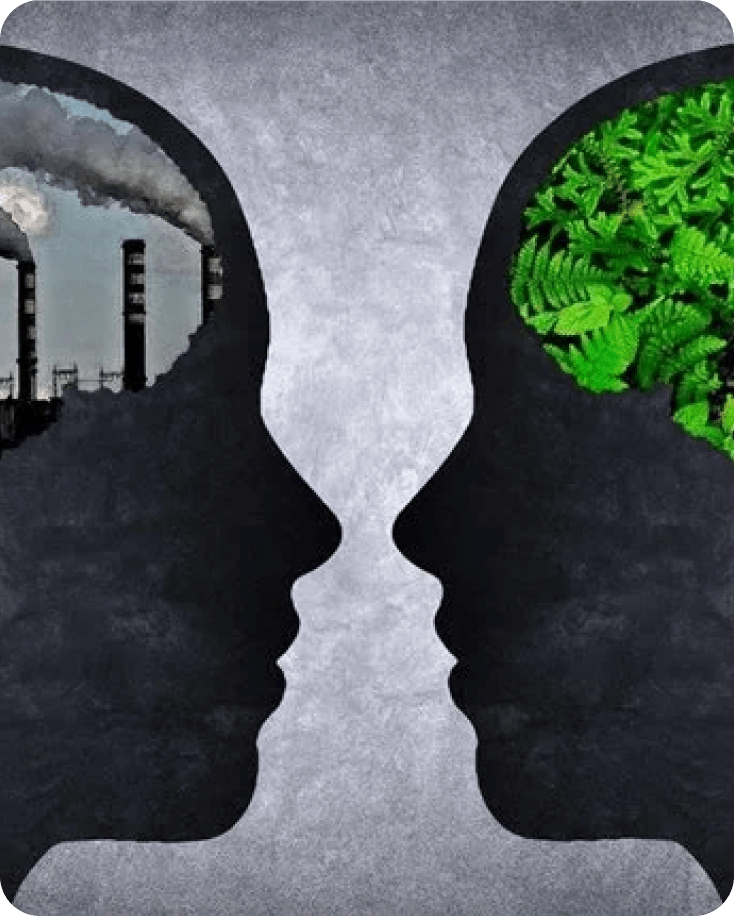कलेलाही रंग असतो म्हणे... पण कोणता रंग? म्हणजे तो प्रत्येक कलेचा वेगवेगळा असतो, की एकच रंग धारण करणाऱ्या वेगवेगळ्या कला असतात? आणि प्रत्येक रंगाच्या पाहाव्या तेवढया छटा असतात म्हणे... एकीतून दुसरी, दुसरीतून तिसरी उलगडत जाते...कलेचं कोणतं रूप दाखवतात या छटा? या छटेचा सौम्य-गडदपणा म्हणजे तिच्या मूळ रंगाच्या कलेच्या तिने घेतलेल्या अनुभूतीचे प्रमाण असते का? पण मग प्रश्न उरतो , की अनुभूती वाढत जावी तशी कला सौम्य होत जाते की गडद?
विचार करावा, तर प्रत्येक कलेचा वेगळा रंग हे समीकरण काही पटत नाही. मग सगळ्या कला सगळे रंग धारण करतात, तर तिच्या कोणत्या रूपाचा कोणता रंग म्हणावा आणि त्याची कोणती छटा हे कसं ओळखावं?
नृत्य, गायन, वादन, चित्रकला, शिल्पकला, पाककला, नाट्यकला अशा माणसाला अवगत असलेल्या एक ना अनेक कला. नृत्यकलेचे उदाहरण घ्यायचे झाले, तर नृत्याचा जेव्हा आवेशपूर्ण प्रकार आपल्यासमोर सादर होतो,तेव्हा तो लाल. माध्यलयीतील विविध हालचालींनी युक्त नृत्यप्रकार, तो पाण्यासारखा निळा. अभिनययुक्त नृत्य असेल तर ते पिवळा रंग आणि त्याच्या अनेकानेक छटा. उत्स्फूर्त भावनेतुन प्रकटलेलं सामूहिक नृत्य म्हणजे समृद्धीच्या हिरव्या रंगाच्या नानाविध छटा म्हणता येतील का ?
ही झाली माणसाची कला....
निसर्गही गजब कलाकार आहे म्हणे... नवनिर्मिती त्याची कला...! सप्तरंगी इंद्रधनू हे त्याचं प्रतीक! फूलणं ही फुलाची कला. उगवणं ही सूर्याची कला. कोसळणं ही पावसाची कला तर वाहणं ही नदीची कला.
फुलाच्या फुलण्याच्या कलेचा रंग असावा गुलाबी, पण ते कोमेजतं तेव्हा....? हाच गुलाबी रंग काळ्यात मिसळून जात असेल का?
सूर्य उगवतो,तो केशरी अश्वावर स्वार होऊन. मावळतीलही तो त्याच रथावर आरूढ असतो. पण मागे मात्र काळोख सोडून जातो. मग हा काळा रंग कलेचा अंत म्हणावा की तिच्या परिवर्तनाची नांदी?? रात्रीच्या काळोखातच चंद्राचं चांदणं पडावं, तसा काळा रंग आला की पांढरा आलाच .!
सगळे रंग एकत्र आले, की त्यांचा पांढरा रंग होतो म्हणे. म्हणजे हा पांढरा रंग सर्व कलांची गुंफण दाखवतो का? कारण कोणतीही कला एकटी थोडीच असते? चित्रकलेत रंगसंगती असते, तशी कलांचीही साथ-संगत असतेच ना....!
हे झालं कलेच्या रंगाविषयी...........
पण प्रत्येक रंगालाही अवगत असणारी त्याची एक कला असेल का.........?
-अंकिता अंजली किशोर.

Getting into engineering felt like getting into an arranged marriage. I had no idea what I was getting into, save for the branch title that had been assigned to me based on my CET score. On my first day at GECA, I found myself in the Engineering Graphics Lab wondering about the significance of engineering drawing and its potential applications in my branch. Prof. Hambire soon introduced himself and interestingly began the lecture with a question for everyone: “Who do you wish to become in your career?”
I found my clueless brain scanning through my old school report cards where I had bumped into that very question year after year and had always responded with the same answer: “an IAS officer”—something my parents always associated prestige with. Somehow, at that moment, the answer felt out of place and I went for something equally prestigious while also being consistent with the room I was sitting in. “An IES officer”, I replied with part pride and part hesitation; the latter because I knew I didn’t have an answer to his next question: “Why?”
More days in the college only helped to reinforce my speculation: most students were unsure why they had pursued engineering. When questioned about the specifics, the answer almost always was a combination of the same ad hoc rationalizations — “because this branch has the most scope”, “this field pays well”, “my parents convinced me into it”, “this is the most I could get with my CET scores”, and the infamous “well, it was this or medical”. Only a handful of them seemed to care about technology or innovation or solving problems of society.
Some could argue that it is possible to cultivate talent and interest with time and with the right atmosphere. Undoubtedly. But constant inundation of apathetic students only adds to the problem: it is the students who create the atmosphere and not the other way around. It only follows that students who are just there ‘for the degree’ find all sorts of ways to cheat the system all-the-while blaming it for their inadequacy to meet industry standards as good engineers.
College is only supposed to guide students, not handhold them through every step of the way—which brings me to my chief argument why most students won’t have fulfilling careers.
Students here are over-dependent on several factors.
Over-dependence on Institutions
Students of GECA and several other colleges are seriously limited in their propensity to achieve without steady supervision of college. Having spent three years in the college hostel, I have encountered many students attending classes and practical labs, turning in projects and assignments, but rarely someone working on a self-funded drone just for pure fun. Even those with sprouting interests hold back until announcements of semester projects and Tech competitions to indulge in making practical engineering applications.
A good chunk of population conflates their CGPA with academic excellence and gets turned down by employers for their lack of industry-relevant skills. Being an engineering student isn’t about studying concepts ‘x’, ‘y’ and ‘z’ so that he or she can secure a job in companies ‘a’, ‘b’ or ‘c’; it is about solving problems through creativity and innovation—something valuable to any company and every part of society. Being in an engineering college cannot make you an excellent engineer any more than being in an English-medium school can make you a fluent English speaker.
Over-dependence on Parents
This complaint is not exclusive to students of GECA: most Indian students rely on their parents for the places they rent, the food they eat, and even the hobbies they develop. Although coming from a good place, this kind of benevolence circumscribes student lives to a bubble of comfort and ends up doing more harm than good. In the end, it is not unheard for a student of GECA seeking parental aid to secure internships and jobs because he or she lacked skills and professional connections to do so on their own.
Compare this to a country like the USA or Japan, where students manage their college tuitions alongside renting houses and working part-time jobs. Their self-sufficiency enables them to undertake several tasks of responsibility, teaches various social and managerial skills, while also granting them freedom to pursue hobbies and ventures in career.
Over-dependence on Prestige
Indian society is so fixated on prestige that we often overlook the grassroots of what makes something prestigious. It has repeatedly been proven that prestige follows excellence and not necessarily the other way around. Many Indian students are overfamiliar with the quote from ‘3 Idiots’: “Success ke peeche mat bhaago, excellence ka peecha karo, success jhak maarke tumhare peeche ayegi”. Ironically, these are the same students that defy the mantra when they prepare for seats to IITs without having a knack for engineering; or when they, during the placement season, aim for that highly renowned company without sharing its values and purpose.
Over-reliance on prestige as a metric for self-fulfilment is not exclusive to Indian students: Wes De Silvestro, in his blog titled ‘The Prestige Trap’, makes a similar case for students of Harvard who go on working for giants like Google and McKinsey only to return dissatisfied knowing that what they were seeking was deeper than prestigious titles and lucrative salaries.
True Education
Our education system is muddled with countless problems—from societal pressures to lackluster student priorities. We have deviated a long way from the original goals of education. What used to be, since the days of Gurukula, a self-learning process of discipline, intellect, practical skills, and mindfulness has been shrouded by a mechanism that operates through competition, grades, and an over-reliance on an outdated academic structure.
A great outlook to true learning comes from Sir Rabindranath Tagore: “True education is not pumped and crammed from outward sources, but aids in bringing to the surface the infinite hoard of wisdom within”.
Prof. Hambire, in the same class of Engineering Graphics, told us that only ten per cent of us were going to end up staying in the engineering profession and that we should strive to make a difference with whatever we choose to do in life. Change starts from within and unless we learn to think for ourselves and take charge of our flaws as students, the Indian education system cannot rise to its full potential.
-Team Catalyst

‘The application of scientific knowledge for practical purposes.’ This comes up after a simple google search regarding technology. We now live in an era that has generated 90% of the world’s data just in the last 2 years. This might come as a surprise that the technological progress we have made, the planets we have discovered, the cells we have observed, the complex machines we have nurtured and the quality of health we have sustained, the definition of technology is nothing but simple. Technology has existed for as long as man has, stone tools and the discovery of fire literally ignited and shaped the development of modern technology.
Man has always wanted to make his life easier, you name it and our race has put in tremendous efforts to reduce the work we put into the task. That is quite what tech is supposed to do, it is supposed to make our life easier. I dare you to think of something that you love to do that DOESN’T involve technology in it. Anything that might feel ‘non-technological’ on the surface has its roots in technology. Technology has made accessing information a lot easier, saves time to access the very info, and has highly made the ‘disable-d’ more ‘able-d.’
This might sound cheesy but yeah you guessed it, every coin has two sides, and this really simple but avidly complex topic has got its nay-nays too. In the 21st century, also called the century of most technological development by far, it easy to think about the drawbacks of technology, data security, and privacy. While the stone tools used by men helped them as hunter-gatherers, it also meant that tribes having an excess of this piece of tech were a lingering threat to others. The invention of the inadvertently famed Gutenberg press revolutionized the print industry as we know it today but also quickly became the cause for excess pollution and toxic waste. The invention of the automobile greatly reduced travel times and efforts but again nature took a hit. You won’t disagree when I’d say the advantages and disadvantages of technology are highlighted by the use rather than the existence.
Technology can change a user’s mental and emotional state. Drugs, especially psychoactive drugs have the same job. Technology and drugs more often than not have become mood regulators. Drugs are technology and technology is drugs, that’s the world we live in now.
Artificial intelligence is not unheard of in the day and age we live in today. It enables the most unsuspecting things that we humans perform every day. Scrolling through social media, binge-watching entertaining content, googling stuff, and even unlocking your phone with biometrics. It won’t be long enough that we eradicate language barriers, have driverless transport, predict the next big health disaster or even aid in making sound investment decisions for individuals and firms alike all of this owing to the further development of AI. Like any new technology, AI has faced much backlash and curbs owing to its potential power and usage. Where AI was used to secure already secured networks and detect fake or unverified news items, it has inevitably also enabled the replacement of a human workforce for a certain job, creation of a constant ‘lab-rat,’ biased virtual environment, and has accelerated hacking processes to a certain extent. Very few, large conglomerates have control over a vast majority of data that they are using at their rather lenient disposal. This has been the root of the enormous war between the law and these multi-billion dollar firms for quite some time now. The ease at which you Google something is also the ease that a hacker can get access to sensitive data at their discretion.
Some great pieces of content like “Black Mirror”, “Unfriended: The Dark Web” and “The Social Dilemma” have very well portrayed the extreme far side of the seemingly all good technology. This is not to make us, the ‘consumers’ of technology (rather than the customers) of it be scared of it but just a mild reality check and a wake-up call to be cautious about the use and misuse of it. “You are as good as the 5 closest people around” might also be changed to “you are as good as the 5 technologies that you use.” In this age where data is the new oil, you as a reader and a user must be safe and informed. Technology enables prosperity but doesn’t necessarily inhibit doom.
-Team Catalyst

“One of the most stupid questions that one can ask a child is, "What do you want to be when you grow up?" As if growing up is finite. As if at some point you become something, and that is the end.”- Michelle Obama
From the time we were children, the concept of growth has been portrayed to us as something very tangible, very temporal. So growth has mostly been associated with the successful performing of certain tasks. As a result, the understanding of the concept of growth has been very limited for most of us. Now that we have grown up (physically and intellectually), I feel compelled to ask myself, what do I mean when I say that I’ve grown, and importantly, what it means when I speak of further growth.
When I come to think of it, it occurs that growing, for one, is very subjective. We come across a lot of people who have different needs. An introvert may feel the need to learn how to socialize with people without really overthinking, while an extrovert might just want to learn how to find solitude among all the buzz. One student can feel the need to be the topper of the class, while the other might just want to understand the subject as best he/she can (not that the two are necessarily separate). And when these objectives are fulfilled, it is assumed that we have grown. However the growth occurs, not after the accomplishment of the objective, but during. As cliched as it sounds, growth is actually about immersing ourselves whole-heartedly in whatever pursuit we have undertaken, and in that bid, enjoying ourselves to the fullest, and as a result, becoming something more.
We all feel the need to change differently at different points of time in life. At times, that need arises due to a rather drastic event in our life. Owing to the direness of the situation, we are not really given the time to think about the positive and negative impacts of the change we are adopting or if we want to change at all. After some time though, in retrospect, we do consciously look at that life-changing event and its impact on our life. The best example is how most, or even all of us, chose to reduce our expenses and adopt a minimalistic lifestyle during the lockdown imposed by the pandemic. It even made us realize that we could actually do away with so many other unnecessary things. That we didn’t always have to rely on the maid to wash our clothes. That if my sister and I distributed our chores, we could quite comfortably clean the house, wash the utensils, and still find time to play UNO and watch the latest season of Suits. And above all, we learned how to live happily, even in the worst face of adversity, with love and grit and resilience. This once, when faced with an unprecedented, once-in-a-lifetime event (hopefully), we outgrew ourselves in ways we never imagined. It is in moments such as these that our true nature is revealed, and we are given a chance; no various chances to evolve.
It is not as if the transformations that occurred in the past few years were unprecedented. Change, and thereby growth, have always been present, continually happening, but unnoticeably slow for most of the part, unless of course, we chose to patiently observe. Only in certain situations is the pace of change so quick, that we are almost compelled to recognize, rather watch out for the paradigm shifts, for example terror attacks, world wars or pandemics… And there is beauty in these events, too; obviously not in the havoc they wreck, but in the opportunity they provide. To pause, reflect, unlearn, relearn, help those in need, and make the world a better place. In that bid, we realize that we become something more. And that is the realization of having grown.
Such is the nature of growth. Short-lived at times, but ever-lasting. Constant, yet occurs in moments. Inherent, yet unnoticed.
With fleeting of days
And passing of time
Ever-present, yet unnoticed and mimed.
Becoming is a process, not finite
Growth is a ladder, its length infinite.
-Team Catalyst

Sadness (Shivam) – A gloomy fellow, always in low spirits when faced with any situation.
Anxiety (Alok) – A person who overthinks whatever life throws at him.
Gratitude (Gopal) – A god-fearing person, always trying to do good to others and thanking people along the way.
Compassion (Carl) – A soft spoken individual, always respectful and considerate of other people’s opinions.
Mindfulness (Mohit) – A high performing college athlete who believes in setting goals and then achieving them.
5 individuals who are in their early – twenties, have completed their education and have just found themselves a job. They had to undergo very harsh difficulties in completing their education which caused them extreme stress.
The characters are sitting in their rooms and speaking to each other over a conference call. The time of the year is such these friends used to meet once every year but this time it couldn’t be possible due to the restrictions.
S – Hi
A – Hello
G – Hi
S – Kya chal raha hai aaj kal ?
C – I have been reading the book ‘how to win friends and influence people’ by Dale Carnegie.. kaafi kuch seekhne ko mila usme se
A – Mai to Sadhguru ke videos dekh dekh ke waqt kaat raha hu..
G – I was volunteering in a mental health awareness camp that I was speaking to you’ll the other day…
M – Sahi hai… mera to bas work from home, exercising aur meditation chal raha hai..
G – Tera kya Shivam??
S – Are mai to apne room ke bahar nikla hi nahi hu itne dino se
C – Yaar.. uske tanhaai ka mazak mat udhao yaar…
M – It’s all a result of him not taking his physical health seriously…bola tha maine
G – Baat wo hai hi nahi.. iska humesha se aisa hi hai… dukh nikalte rehna bas
A – Tum logo ko aisa nahi lagta hai kya ki apne jo darr ya fears hai.. wo hi shayad apne ko push karne ka try karte sahi raaste pe
S – No way.. darr ke thought se hi mera fatt jaata hai… usko experience karna is another level only..
M – What are you saying… darr hi to wo cheez hai jisse apne ko wo rush milta hai.. yaa to apne aap ko better karne ka yaa fir aur gehre kue me gira dene ka
C – “Don’t be afraid of enemies who attack you. Be afraid of the friends who flatter you.” Kal hi padha book me..
M -

G - LOL
A – Faltu baate baad me.. Insta pe tune wo Shyam ka update dekha kya.. college me koi puchta nahi tha usko aaj sabka hero ban raha hai wo..
S – Haa yaar.. mujhe bhi dekhke shock laga ..
M – Nahi yaar… uska status khaali social media pe active dikhta.. baaki saara time bhi wo apne phone pe hi guzarta hai mera ek friend bola.
C – It’s probably true..social media sites are creating more emotional disconnection rather than connection
M – Negative mindset ke log mujhe bilkul pasand nahi..

S – Apne senior ka job chhut gaya ye pandemic me.. abhi wo ghar se hi online groceries ka business kar raha hai uske colony walo ke liye..
A – Saare plans chhod diye usne apne??
S – He’s saying side by side pursue karta rahega till things get back to normal..
C – Kaafi daring wala move liya hai usne… chahta to baithke ro sakta tha apne situation pe…
M – That’s true.. aise decisions lena aasan nahi hai.. lekin challenging situations me koi bhi viable option pe jyada sochna nahi chahiye..
G – Sahi to hai.. waise bhi alag alag source se income aane ka apan humesha try karte rehte the.. isse better mauka kya hoga uspe work karne ka.
S – Ek baat to manna padhega lekin.. Mohit hai bohot optimistic saala…
M – If I have learnt anything in all these years… is that if you keep your mind and body fit.. your soul will remain happy..

A – No that’s true.. college ke time me bhi mental struggles mai bohot help kiya tha isne..
M – Aur kuch hai to Carl ke kitaabi pravachan ke wajah se alag hi perspective mila hai har cheez pe..
G – Merko to humesha lagta hai ki agar apan ek dusre se nahi mile rehte .. to shayad wo chaar saal bohot kharaab jaate..

*Bhavna was added*
E – “The best and most beautiful things in the world cannot be seen or even touched. They must be felt with the heart” You can’t logic your way through emotion.

“Problems cannot be solved at the same level of awareness that created them.”
-Albert
Einstein
Over the last 25 years, the global economy has doubled, while half of the total ecosystem has
degraded. Global carbon emissions have increased by 40% since 1990. However, economic growth, which is supposed to
bring prosperity, has been limited to a few countries, mainly located in the Global North. Today’s world is
characterized by substantial global inequalities; For example, one-fifth of the world’s population earns only 2% of
the global income. Countries of the Global South are also striving for the prosperity of the northern countries. But
what does a world look like in which 8 billion people live at western prosperity levels and what consequences will
result?
Economic growth is an integral concept for all stakeholders in society. In developing third-world
nations, approximately 60% of the population survives on a per capita income of less than $1,000 per year. These
numbers suggest a very stark reality concerning the astounding growth that we have seen in the decades'
post.
In the developed economies of the world, the wealth that the nations have created has been by rapid
economic growth. In that process, vast amounts of greenhouse gases had been produced which had led to the climate
advocates complaining of the unchecked growth that had taken place with no regard to the living standards of future
generations.
As horrible as that might sound, these nations have high per capita income, a guaranteed social
security system (basically, someone to take care of you in troubled times), quality healthcare, a low unemployment
rate, cutting edge science and technology and many more. However, these countries have their problems but have a
minimum standard of living to rely upon.
The dialogue in the country and the world around the environment is
becoming impaired by the thought that you need to save it otherwise you will be: burnt to death, drinking water will
get over, rising sea levels will flood your roads and homes; Basically, humankind will cease to exist. In our
country, people fail to understand that any development agenda being proposed by the authorities is not a direct
threat to their existence. Our past has been such that the inherent socialistic attitude in India has failed us. It
has done so by not providing the valuable insight that the economic revolution by way of manufacturing, building of
world-class infrastructure, healthcare facilities, quality education will require us to make some sacrifices to
achieve the prosperity and well-being that the forefathers of our nation dreamed off.
We need to understand that
to prosper as a nation we have to make some trade-offs. All of the things that we talk about as a nation:
demographic dividend, resource-rich, etc. can only be capitalized on if we take the initiatives required. The
important thing here for us to understand is that there is no one size fits all solution. We have to assess the
situation and then make decisions accordingly such that the benefit reaches the last person. Several nations have
taken various steps (China, Japan, South Korea, Taiwan) and have had drastic short-term impacts on the economy but
have worked out well in the long run.
The trade-off between environmental protection and economic growth has been
discussed for half a century. What we have learned is that government regulations requiring pollution control are
“technology-forcing” and encourage the modernization of industry and infrastructure. A marginal business that can’t
afford pollution control technology would not last very long anyway. But the investment in environmental clean-up
often stimulates other upgrades that enable businesses to more effectively compete in a global economy. Moreover, a
clean environment reduces illness and that reduces the need for expensive health care. Clean air also attracts
businesses, residents and tourists.
We are not saying that the market economy is the holy grail and should be
followed relentlessly. Of course, when there is absolute faith shown in any form, things can be abused and taken for
granted. Like any other well-functioning economy, checks and balances must be put in place to counter anything wrong
that is being pursued. But it is in the best interests of the citizens that they accept the ground reality if they
want to considerably improve as a society.


